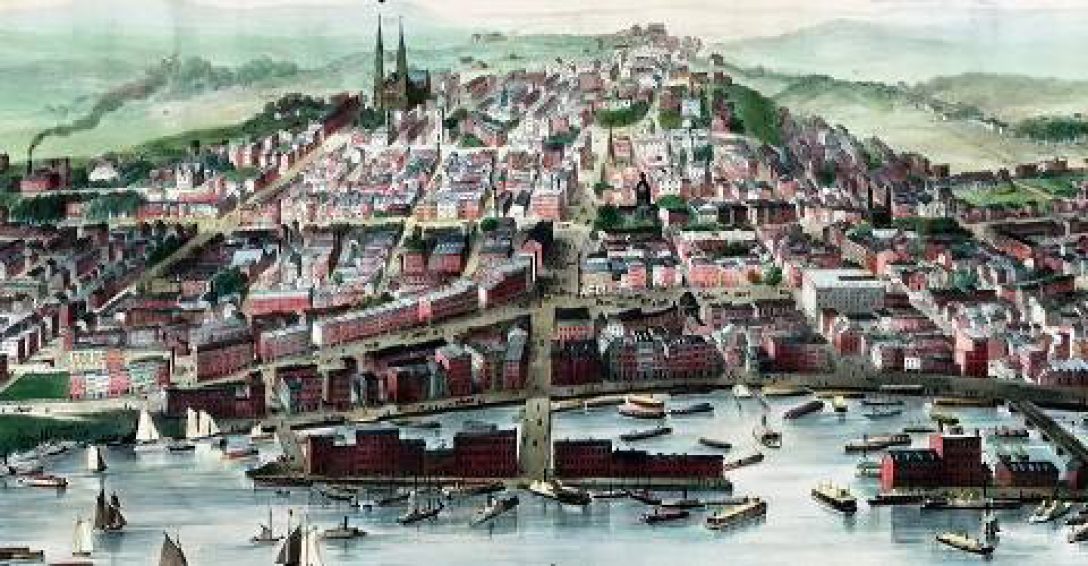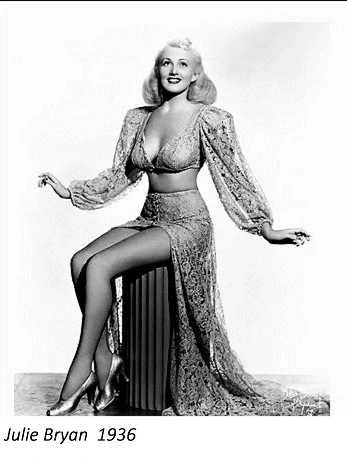 A small article in a 1936 Albany “Times Union” caught our eye. Julie Bryan from Albany was selected to be the understudy for Gypsy Rose Lee in the “Ziegfeld Follies”.
A small article in a 1936 Albany “Times Union” caught our eye. Julie Bryan from Albany was selected to be the understudy for Gypsy Rose Lee in the “Ziegfeld Follies”.
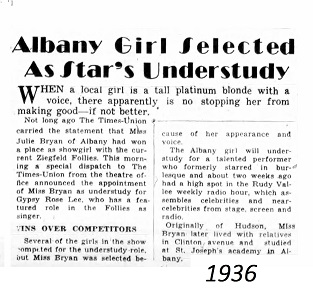
Julie was born in Hudson, but at some point came to live with relatives on Clinton Ave. in Albany (probably after 1925 when her father died; her older brothers still lived in Hudson in 1930.) In an interview with the “Daily Worker” in 1936 she said she’d attended St. Joseph’s Academy on N. Swan, and played the lead in “The Story of the Miraculous Medal”. By our calculations she was about 16 when she left school and went out into the world. That would have been in 1933, at the height of the Great Depression. She told the interviewer she’d done some modeling, some touring with stock companies around the country, and had been selected in a contest for the Follies to become a Ziegfeld Girl and Gypsy’s understudy.
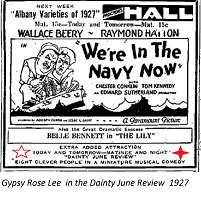 (In just 4 years Gypsy Rose Lee had become a household name as a burlesque queen vs. playing part of a horse in the vaudeville circuit “Dainty June Revue”. The Revue appeared in Albany in 1927 at the Harmanus Bleecker Hall Theater on Washington Ave, next to the Armory – the main branch of the Albany Public Library is in that location today). By late 1928 “Dainty June”, star of the act and Rose’s sister, had run off to get married. Rose Louise stepped into the breech, became Gypsy – the rest is history.)
(In just 4 years Gypsy Rose Lee had become a household name as a burlesque queen vs. playing part of a horse in the vaudeville circuit “Dainty June Revue”. The Revue appeared in Albany in 1927 at the Harmanus Bleecker Hall Theater on Washington Ave, next to the Armory – the main branch of the Albany Public Library is in that location today). By late 1928 “Dainty June”, star of the act and Rose’s sister, had run off to get married. Rose Louise stepped into the breech, became Gypsy – the rest is history.)
We can only imagine what it meant for Julie to become a Ziegfeld Girl*. The Ziegfeld Follies were a musical revue, featuring song, dance, beautiful girls, vaudeville comedy, and more beautiful girls, modeled after the Follies Bergeres in Paris. It started in 1907 By Flo Ziegfeld, and had been the springboard for, and featured, stars like Sophie Tucker, Fanny Brice, W.C. Fields, Eddie Cantor, Will Rogers, Louise Brooks, Barbara Stanwyck, Joan Blondell, and Eve Arden. Being a Ziegfeld Girl was the epitome of glamour.
The girls were famous – for their beauty and poise; acclaimed the world over. Being a Ziegfeld Girl was the stuff of dreams for young girls, especially in the midst of the Depression. It’s interesting that in her interview Julie not only mentions her salary – $85/week (when the average salary for a man was about $35 and even less for a woman), but also that she’s a member of Actor’s Equity – the union for theatrical workers, and it protected the show girls like Julie.
The 1936 show, at the historic Winter Garden theatre on Broadway, was produced by Billie Burke, widow of Flo Ziegfeld and former Ziegfeld Girl (you probably know her better as Glinda – the Good Witch of the North in the Wizard of Oz). Sets and costumes were designed by Vincente Minelli (who would become a famous movie director in the 1940s and father of Liza Minnelli), included music by Ira Gershwin and choreography by George Balanchine (who founded the NYC Ballet in the 1950s). It was a uniquely American mix of style, sophistication, spectacle and sex. Some say the Follies changed the Broadway musical forever.
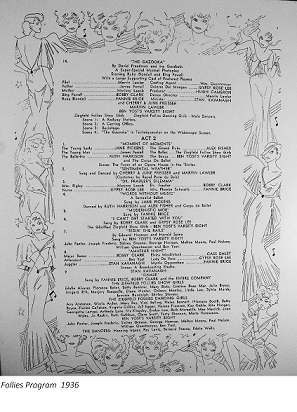
Heady stuff for a young girl from Upstate New York.
It was chance of a lifetime for a kid who had tread the boards in a Catholic high school play. The cast included a mostly unknown comic, Bob Hope and the legendary Fanny Brice. In late 1936 Gypsy left the Follies to try Hollywood, but Julie stayed. (She remained in the chorus – one of the famous “Ziegfeld Girls” and was given a small featured role (“The Girl in Green”).

But the Follies of 1936 was a limited run and would be the last (Billie Burke was moving on to her movie career).

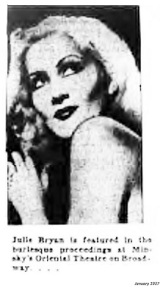 Shortly before it close Julie was “poached” by the Minskys for their new Oriental Theater on Broadway, where she headlined the show – her name was in neon lights in the night sky. Minsky’s burlesque show was a somewhat less upscale version of the Follies (“The Poor Man’s Follies”) and almost as famous (and it was where Gypsy got her start). It was the same combination of schtick vaudeville comedy (Phil Silvers and Alan Alda’ father Robert shared the bill Julie Bryan), singing and dancing, with a bit more flesh.
Shortly before it close Julie was “poached” by the Minskys for their new Oriental Theater on Broadway, where she headlined the show – her name was in neon lights in the night sky. Minsky’s burlesque show was a somewhat less upscale version of the Follies (“The Poor Man’s Follies”) and almost as famous (and it was where Gypsy got her start). It was the same combination of schtick vaudeville comedy (Phil Silvers and Alan Alda’ father Robert shared the bill Julie Bryan), singing and dancing, with a bit more flesh.

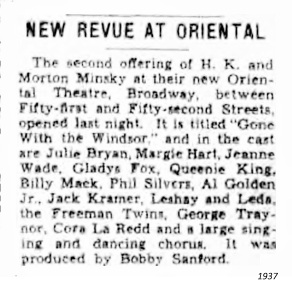

Alas, the days of the Minsky’s on Broadway were numbered. As far as we can tell Julie Bryan was the last featured star before Mayor LaGuardia shut down burlesque theaters in NYC. (He wouldn’t when the Follies was still going strong, but acceded to pressure once it closed – Burlesque on the Great White Way wasn’t to be tolerated.
So where did that leave Julie Bryan? We’re not quite sure. Her name surfaces in a gossip column linked to Frank Fay, former husband of Barbara Stanwyck and a bit-part B movie actor. (There’s always been a story that the movie “A Star is Born” is based on their marriage, when the Svengali-like controlling husband is eclipsed by his wife’s success.)
We do know that in 1939 Julie had a bit part in a movie “Torchy Plays with Dynamite”, the 9th and the last in a series of hugely popular B movies about a feisty young detective. In at least 2 ads, Julie Bryan gets the billing, over Jane Wyman (a/k/a Ronald Reagan’s first wife) who played Torchy.
But either Hollywood didn’t want Julie Bryan or she didn’t want Hollywood. (In her “Daily Worker” interview she intimates that Hollywood might not be for her; she wanted the certainty of a steady paycheck.)
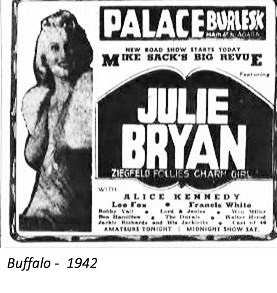 So for the next 9 years we find Julie as queen of the burlesque circuits, with top billing, touring through the Mid-West and Northeast. It was steady good money, and Gypsy Rose Lee had made stripping almost respectable. Along the way, in the mid-1940s, she married comic a couple of years older, Jack Martin, with whom she had toured.
So for the next 9 years we find Julie as queen of the burlesque circuits, with top billing, touring through the Mid-West and Northeast. It was steady good money, and Gypsy Rose Lee had made stripping almost respectable. Along the way, in the mid-1940s, she married comic a couple of years older, Jack Martin, with whom she had toured.
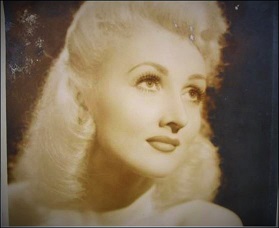

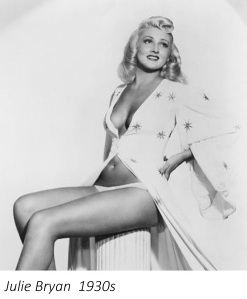
(Just because the theaters were shut down in NYC, didn’t mean burlesque died. There were theaters all over the country including Utica, Rochester and Buffalo (the Buffalo Theater lasted until at least 1969). Often the dancers filled in between movie showings or played midnight shows. The burlesque dancers went into variety reviews (what had been vaudeville, but with a new name) and during and after World War II, they became staple acts in night clubs – luring customers away from the new thing – TV. (Albany had more than a few into the 1960s.)

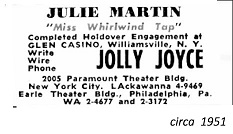 By 1950 Julie would have been in her early 30’s, and the burlesque phase of her life came to an end. We think she briefly took up a new solo act, as Julie Martin, playing nightclubs as “The Queen of Whirlwind Taps”, but that was over within a couple years.
By 1950 Julie would have been in her early 30’s, and the burlesque phase of her life came to an end. We think she briefly took up a new solo act, as Julie Martin, playing nightclubs as “The Queen of Whirlwind Taps”, but that was over within a couple years.
The rest of her life is a blank until we find her in 1994, at the time of her death, back in Hudson, using the name Julie Bryan. There are so many unanswered questions, so if anyone knows anything, please let us know.
But Julie Bryan, the tall, slender, beautiful blond from St. Joe’s, had once been a Ziegfeld Girl. No on one could ever take that away from her. She was a member of a select club of the some of the most glamourous and sought after women of the 20th century.
For the story of another Albany Ziegfeld Girl, read Al Quagieri’s blog post, “A Glamour Girl and her Pig” https://alcue.wordpress.com/…/…/a-glamour-girl-and-her-pig/…
* 3 movies were made about the iconic Ziegfeld Follies, “The Great Ziegfeld” (1936) – William Powell and Myrna Loy, “The Ziegfeld Girls” (1941) – Judy Garland, Hedy Lamar and Lana Turner and “The Ziegfeld Follies” (1945) – Fred Astaire, Lucille Ball, Gene Kelly, Judy Garland, Lena Horne.
Copyright 2021 Julie O’Connor
